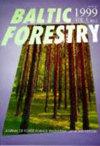土耳其桥栎自然种群叶片形态的变化
IF 0.6
4区 农林科学
Q3 FORESTRY
引用次数: 0
摘要
Quercus pontica K.Koch是一种在土耳其被归类为易危(VU)的残余植物。在这项研究的范围内,需要调查的是桥叶猴种群内部和之间的叶片形态特征是否存在差异。鉴定了7个不同自然省的叶片性状变异。总共选择了99个个体,并从每个灌木中收集了30片叶子,以确定桥梁种群的叶子变化。叶柄长(1.07cm)、叶长(17.13cm)、叶片长(16.13cm),叶宽(8.10cm)、叶面积(93.76cm2)、叶脉角(54.22度)、主脉总数(38.72个)、齿总数(40.73个)、叶柄率(6.34%)、最大宽度叶片相对长度(50.50%)和脉序百分比(98.65%)的平均值在所有种群中确定。方差分析结果显示,种群内个体之间的所有叶片特征都存在显著差异(p<0.01)。通过聚类分析和主成分分析检测种群间的变异。根据分析结果,11个种群分为三类。通过相关分析,确定了叶片性状之间具有统计学意义的关系。在本研究中,我们没有发现环境因素(海拔、坡向、年温度和年降水量)与叶片性状之间的显著关系。关键词:叶形态,桥栎,遗迹,变异本文章由计算机程序翻译,如有差异,请以英文原文为准。
Variation in leaf morphology of Quercus pontica natural populations in Turkey
Quercus pontica K.Koch is a relict plant species which is classified as vulnerable (VU) in Turkey. Within the scope of this study it needed to be investigated are there variations in leaf morphological characteristics within and among Q. pontica populations. Variation in leaf traits in relation to seven different natural provinces was identified. In total, 99 individuals were selected, and 30 leaves were collected from each shrub to determine leaf variations in Q. pontica populations. Mean values for petiole length (1.07 cm), leaf length (17.13 cm), lamina length (16.13 cm), leaf width (8.10 cm), leaf area (93.76 cm2), leaf vein angle (54.22 degree), total number of primary veins (38.72), total number of teeth (40.73), petiole ratio (6.34%), relative length of lamina at largest width (50.50%), and percentage of venation (98.65%) were determined in all populations. The results of the analysis of variance showed significant differences (p< 0.01) among individuals within populations for all leaf characteristics. Variations among populations were detected by cluster analysis and principal components analysis. According to the analysis results, the 11 populations were grouped in three categories. Using correlation analysis, statistically significant relationships between leaf traits were determined. In this study, we detected no significant relationship between environmental factors (altitude, aspect, annual temperature and annual precipitation) and leaf traits. Key words: leaf morphology, Quercus pontica, relict, variation
求助全文
通过发布文献求助,成功后即可免费获取论文全文。
去求助
来源期刊

Baltic Forestry
农林科学-林学
CiteScore
1.60
自引率
0.00%
发文量
23
审稿时长
>12 weeks
期刊介绍:
The journal welcomes the original articles as well as short reports, review papers on forestry and forest science throughout the Baltic Sea region and elsewhere in the area of boreal and temperate forests. The Baltic Sea region is rather unique through its intrinsic environment and distinguished geographical and social conditions. A temperate climate, transitional and continental, has influenced formation of the mixed coniferous and deciduous stands of high productivity and biological diversity. The forest science has been affected by the ideas from both the East and West.
In 1995, Forest Research Institutes and Universities from Estonia, Latvia and Lithuania
joined their efforts to publish BALTIC FORESTRY.
 求助内容:
求助内容: 应助结果提醒方式:
应助结果提醒方式:


